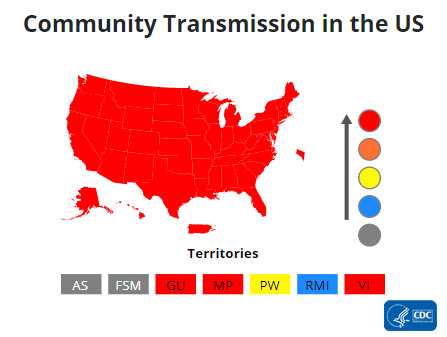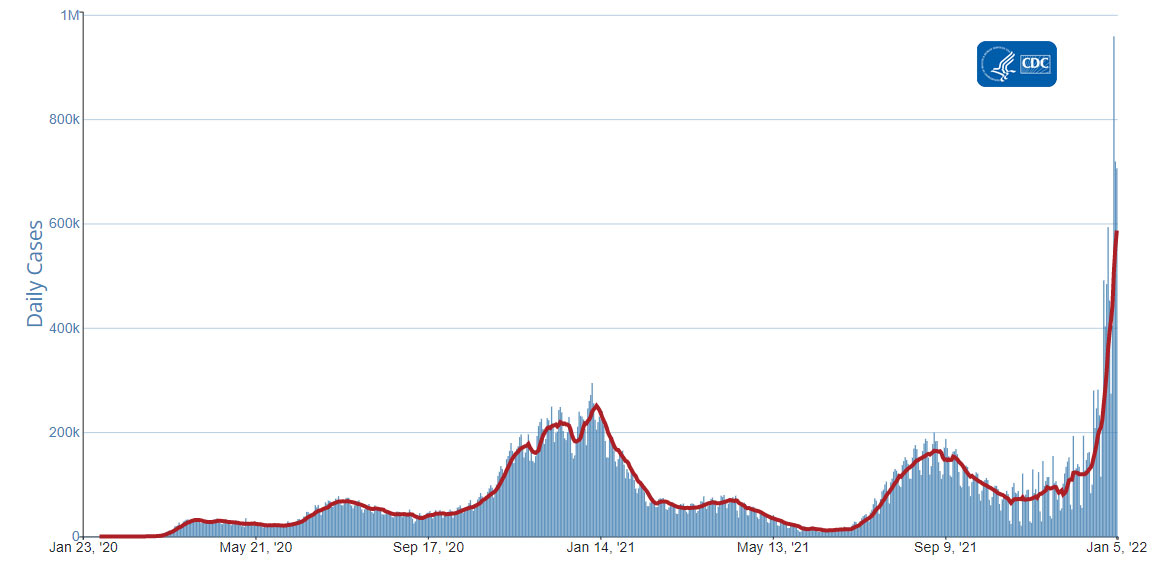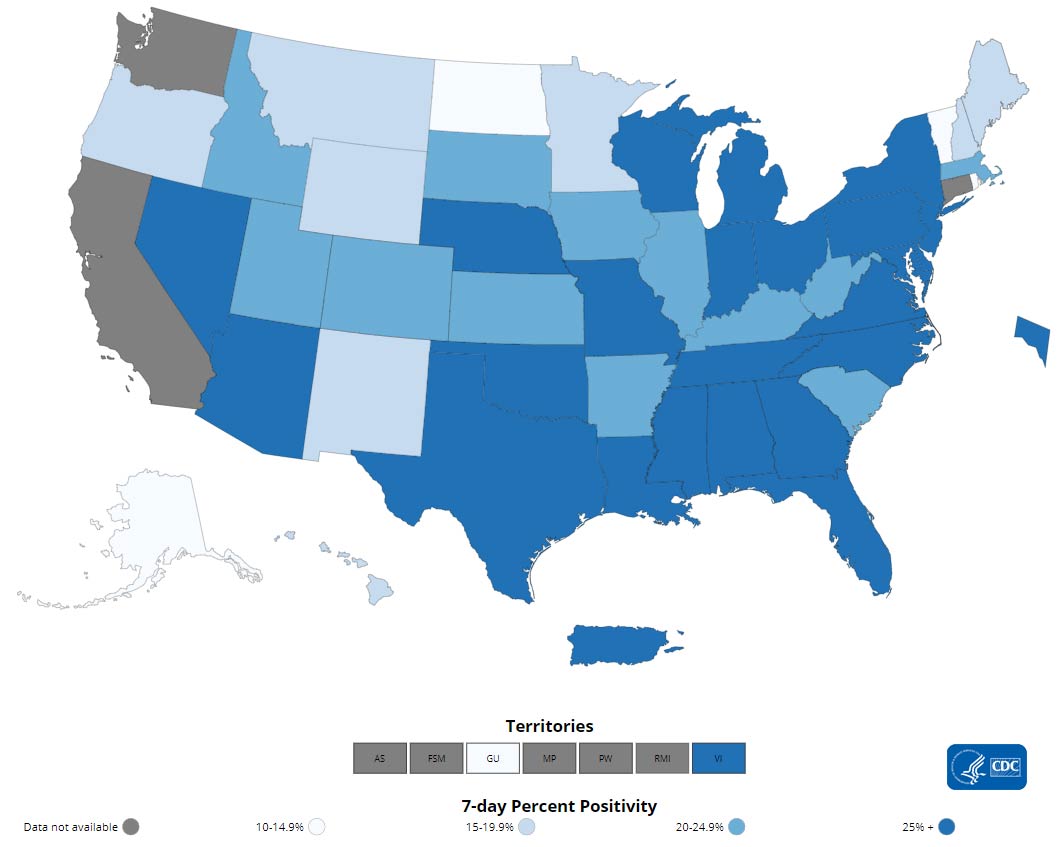Recommendations for Fully Vaccinated People
COVID-19 Homepage
Resolve to be Safe
Interpretive Summary for January 7, 2022
Resolve to be Safe
COVID-19 cases continue to increase rapidly across the United States. This surge is driven by the Omicron variant, which CDC’s Nowcast model projects may account for approximately 95% of cases. On January 5, 705,264 new cases were reported, more than doubling the January 2021 peak. The entire country is now experiencing high levels of community transmission. Hospitalizations are also on the rise. While early data suggest Omicron infections might be less severe than those of other variants, the increases in cases and hospitalizations are expected to stress the healthcare system in the coming weeks.
Given what we currently know about COVID-19 and the Omicron variant, CDC recently updated its quarantine and isolation recommendations for the public.* If you come into close contact with someone with COVID-19, you should quarantine if you are in one of the following groups:
- You are ages 18 or older and completed the primary series of recommended vaccine, but have not received a recommended booster shot when eligible.
- You received the single-dose Johnson & Johnson vaccine (completing the primary series) over 2 months ago and have not received a recommended booster shot.
- You are not vaccinated or have not completed a primary vaccine series.
If you have confirmed or suspected COVID-19, regardless of your vaccination status, stay home and isolate from other people for at least 5 full days. Wear a well-fitting mask when around others at home and in public for an additional 5 days. Testing may be used to help determine when to end your isolation period. For information about when and how to test, visit CDC’s website.
Vaccination remains the best way to protect yourself from COVID-19 and reduce its impact on our communities. Everyone should get vaccinated and boosted as soon as they are eligible, including people who have already had COVID-19. Find a vaccine.
*CDC’s updated recommendations reflect the impact to society, the latest science on disease severity, and when and for how long a person is maximally infectious. CDC will continue to evaluate these recommendations as more data become available.
Note to readers: You quarantine when you might have been exposed to the virus and may or may not have been infected. You isolate when you have been infected with the virus, even if you don’t have symptoms. When counting days for isolation, day 0 is the first day of symptoms. If you are asymptomatic, day 0 is the day of your positive viral test. For more information, visit CDC’s website.
- COVID Data Tracker’s County View tab now displays timeseries data at the state level.
- COVID Data Tracker’s County View tab now includes county-level booster data for the populations 18+, 50+, and 65+.
- The map on COVID Data Tracker’s Vaccine Equity tab now has an option for the population 5 years and older.
- COVID-19 Vaccine Safety in Children Aged 5–11 Years — United States, November 3–December 19, 2021
- Investigation of a SARS-CoV-2 B.1.1.529 (Omicron) Variant Cluster—Nebraska, November–December 2021
- Evaluation of a Test to Stay Strategy in Transitional Kindergarten Through Grade 12 Schools — Los Angeles County, California, August 16–October 31, 2021
- Evaluation of Test to Stay Strategy on Secondary and Tertiary Transmission of SARS-CoV-2 in K–12 Schools — Lake County, Illinois, August 9–October 29, 2021
- Receipt of COVID-19 vaccine during pregnancy and risks for preterm or small-for-gestational-age birth – Eight Integrated Health Care Organizations, United States, December 15, 2020 – August 4, 2021
- Risk Factors for Severe COVID-19 Outcomes Among Persons Aged ≥18 Years Who Completed a Primary COVID-19 Vaccination Series — 465 Health Care Facilities, United States, December 2020–October 2021
- Risk for Newly Diagnosed Diabetes >30 Days After SARS-CoV-2 Infection Among Persons Aged <18 years — United States, March 1, 2020–June 28, 2021
- Effectiveness of BNT162b2 (Pfizer-BioNTech) mRNA Vaccination Against Multisystem Inflammatory Syndrome in Children Among Persons Aged 12–18 Years — United States, July–December 2021
Reported Cases
As of January 5, 2022, the current 7-day moving average of daily new cases (586,391) increased 85.7% compared with the previous 7-day moving average (315,851). A total of 57,898,239 COVID-19 cases have been reported in the United States as of January 5, 2022.
Currently two variants, Omicron and Delta, are classified as Variants of Concern (VOC) in the United States. CDC’s COVID Data Tracker shows that the proportion of the Omicron variant circulating in the United States is predicted to increase from the week ending December 25, 2021 and is the predominant variant in the United States. Nowcast projections* for the week ending January 1, 2022, predict the national proportion of Omicron to be 95.4% (95% PI 92.9-97%) and Delta to be 4.6% (95% PI 2.9-7%). Omicron is predicted to be greater than 75% in all HHS regions.
57,898,239
Total Cases Reported
57,898,239
Total Cases Reported
586,391
Current 7-Day Average**
586,391
Current 7-Day Average**
315,851
Prior 7-Day Average
315,851
Prior 7-Day Average
+85.7%
Change in 7-Day Average since Prior Week
+85.7%
Change in 7-Day Average since Prior Week
*The median time from specimen collection to sequence data reporting is about 3 weeks. As a result, weighted estimates for the most recent few weeks may be unstable or unavailable. CDC’s Nowcast is a data projection tool that helps fill this gap by generating timely estimates of variant proportions for variants that are circulating in the United States. View Nowcast estimates on CDC’s COVID Data Tracker website on the Variant Proportions page.
**Historical cases are excluded from daily new cases and 7-day average calculations until they are incorporated into the dataset for the applicable date. Of 352,811 historical cases reported retroactively, 134 were reported in the current week and 621 were reported in the prior week.
Vaccinations
The U.S. COVID-19 Vaccination Program began December 14, 2020. As of January 5, 2022, 513.8 million vaccine doses have been administered in the United States. Overall, about 245.3 million people, or 73.9% of the total U.S. population, have received at least one dose of vaccine. About 206.8 million people, or 62.3% of the total U.S. population, have been fully vaccinated.* About 72.3 million additional/booster doses in fully vaccinated people have been reported. As of January 5, 2022, the 7-day average number of administered vaccine doses reported (by date of CDC report) to CDC per day was 1,075,148, a 3.1% increase from the previous week.
CDC’s COVID Data Tracker Vaccination Demographic Trends tab shows vaccination trends by age group. As of January 5, 2022, 95.0% of people ages 65 years or older have received at least one dose of vaccine and 87.7% are fully vaccinated. For people ages 18 years or older, 85.9% have received at least one dose of vaccine and 73.0% are fully vaccinated. For people ages 12 years or older, 84.0% have received at least one dose of vaccine and 71.3% are fully vaccinated. For people ages 5 years or older, 78.5% have received at least one dose of vaccine and 66.2% are fully vaccinated.
513,839,973
Vaccines Administered
513,839,973
Vaccines Administered
245,278,020
People who received at least one dose
245,278,020
People who received at least one dose
206,797,799
People who are fully vaccinated*
206,797,799
People who are fully vaccinated*
73.9%
Percentage of the U.S. population that has received at least one dose
73.9%
Percentage of the U.S. population that has received at least one dose
62.3%
Percentage of the U.S. population that has been fully vaccinated*
62.3%
Percentage of the U.S. population that has been fully vaccinated*
+0.7
Percentage point increase from last week
+0.7
Percentage point increase from last week
+0.4
Percentage point increase from last week
+0.4
Percentage point increase from last week
*Represents the number of people who have received the second dose in a two-dose COVID-19 vaccine series (such as the Pfizer or Moderna vaccines) or one dose of the single-shot Johnson & Johnson’s Janssen vaccine.
Hospitalizations
New Hospital Admissions
The current 7-day daily average for December 28, 2021–January 4, 2022, was 16,458. This is a 60.2% increase from the prior 7-day average (10,271) from December 21–December 27, 2021.
3,773,704
Total New Admissions
3,773,704
Total New Admissions
16,458
Current 7-Day Average
16,458
Current 7-Day Average
10,271
Prior 7-Day Average
10,271
Prior 7-Day Average
+60.2%
Change in 7-Day Average
+60.2%
Change in 7-Day Average
The start of consistent reporting of hospital admissions data was August 1, 2020.
Daily Trends in Number of New COVID-19 Hospital Admissions in the United States
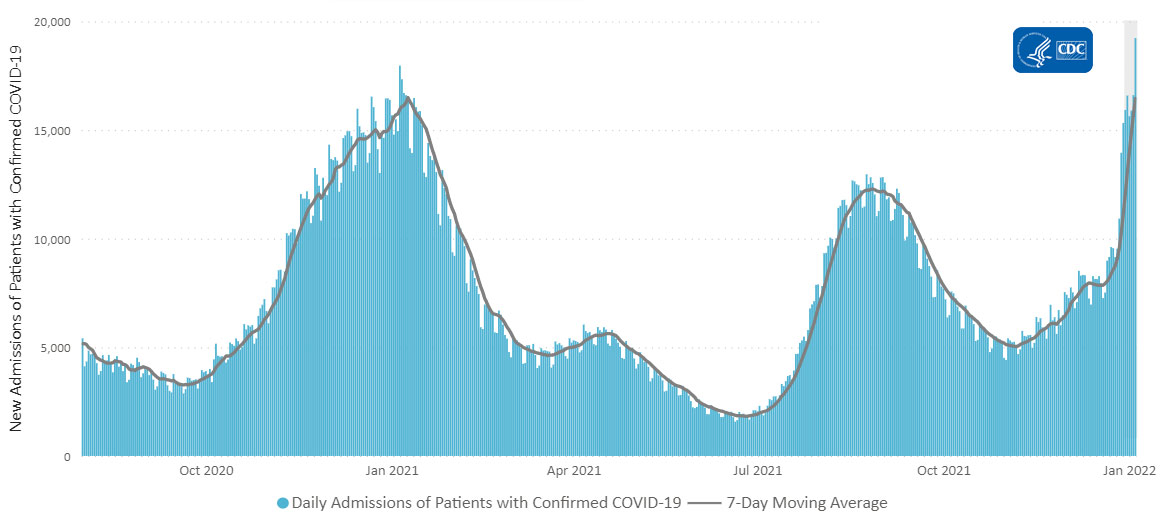
New admissions are pulled from a 10 am EST snapshot of the HHS Unified Hospital Timeseries Dataset. Due to potential reporting delays, data from the most recent 7 days, as noted in the figure above with the grey bar, should be interpreted with caution. Small shifts in historic data may also occur due to changes in the Centers for Medicare and Medicaid Services (CMS) Provider of Services file, which is used to identify the cohort of included hospitals.
COVID-NET: Hospitalization Rates in Children Ages 4 Years and Younger
CDC’s Coronavirus Disease 2019-Associated Hospitalization Surveillance Network (COVID-NET) shows that hospitalization rates remain elevated in young children. For the week ending December 18, the weekly rate of COVID-19-associated hospitalizations for children ages 4 years and younger is 2.5 per 100,000. The rate of hospitalization in this age group is higher than rates seen for both older children ages 5–11 years (0.5 per 100,000) and adolescents ages 12–17 years (1.5 per 100,000). Unlike older children and adolescents, children ages 4 years and younger are not yet eligible for any of the available COVID-19 vaccines.
Hospitalization Rates in Children Ages 4 Years and Younger

The Coronavirus Disease 2019 (COVID-19)-Associated Hospitalization Surveillance Network (COVID-NET) is an additional source for hospitalization data collected through a network of more than 250 acute-care hospitals in 14 states (representing ~10% of the U.S. population). Detailed data on patient demographics, including race/ethnicity, underlying medical conditions, medical interventions, and clinical outcomes, are standardized case reporting form.
Deaths
The current 7-day moving average of new deaths (1,246) has increased 14.4% compared with the previous 7-day moving average (1,089). As of January 6, 2022, a total of 829,740 COVID-19 deaths have been reported in the United States.
829,740
Total Deaths Reported
829,740
Total Deaths Reported
1,246
Current 7-Day Average*
1,246
Current 7-Day Average*
1,089
Prior 7-Day Average
1,089
Prior 7-Day Average
+14.4%
Change in 7-Day Average Since Prior Week
+14.4%
Change in 7-Day Average Since Prior Week
Daily Trends in Number of COVID-19 Deaths in the United States Reported to CDC

7-Day moving average
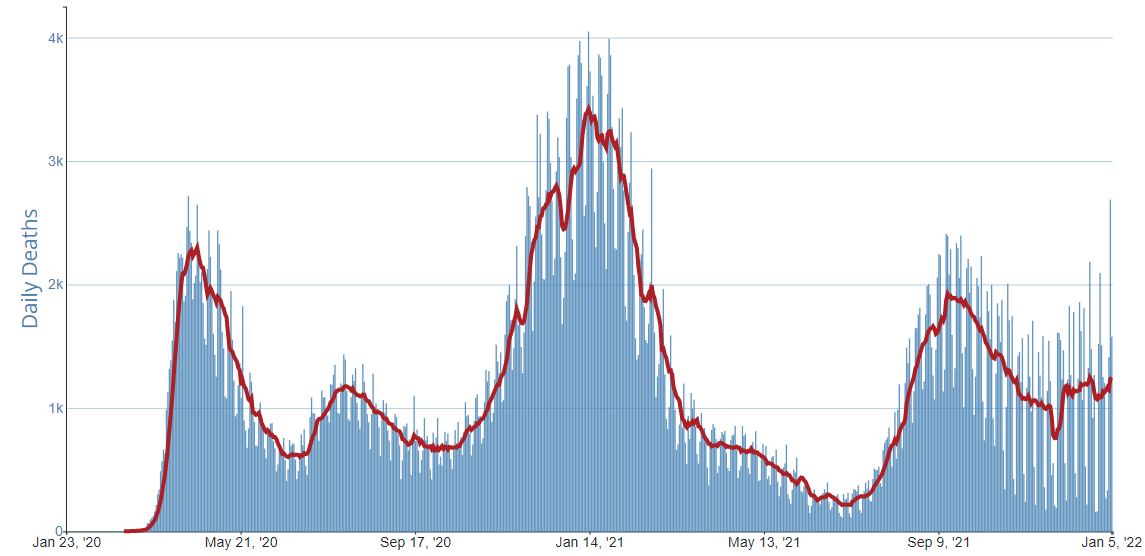 More Death Data
More Death Data*Historical deaths are excluded from the daily new deaths and 7-day average calculations until they are incorporated into the dataset by their applicable date. Of 19,432 historical deaths reported retroactively, 337 were reported in the current week; and 3,136 were reported in the prior week.
Testing
The percentage of COVID-19 NAATs (nucleic acid amplification tests)* that are positive (percent positivity) is increasing in comparison to the previous week. The 7-day average of percent positivity from NAATs is now 27.2%. The 7-day average number of tests reported for December 24 – December 30, 2021, was 1,652,836, down 9.1% from 1,818,038 for the prior 7 days.
725,247,503
Total Tests Reported
725,247,503
Total Tests Reported
1,652,836
7-Day Average Tests Reported
1,652,836
7-Day Average Tests Reported
27.2%
7-Day Average % Positivity
27.2%
7-Day Average % Positivity
17.9%
Previous 7-Day Average % Positivity
17.9%
Previous 7-Day Average % Positivity
+9.32
Percentage point change in 7-Day Average % Positivity since Prior Week
+9.32
Percentage point change in 7-Day Average % Positivity since Prior Week
*Test for SARS-CoV-2, the virus that causes COVID-19
A Closer Look
A Closer Look Section presents more detailed information for readers who want to learn more about current issues of interest.
A Closer Look: Update on the Omicron Variant
Since identifying the first case of the Omicron variant in the United States on December 1, 2021, CDC has been working with state, tribal, local, and territorial public health officials to monitor the spread of Omicron in the United States. On December 10, 2021, CDC released an MMWR article summarizing characteristics of the first Omicron infections in the country. CDC has also identified a rapid increase in infections consistent with what has been observed in other countries. Increases in infections are most likely due to a combination of two factors: increased transmissibility and immune evasion (the ability of the variant to evade immunity conferred by past infection or vaccination). Though the precise contribution of each of the two factors remains unknown, a substantial degree of immune evasion is likely as has been demonstrated in early in vitro studies.
CDC uses genomic surveillance to track variants of SARS-CoV-2 in the United States. CDC’s national genomic surveillance can detect a variant that is circulating at 0.1% frequency with 99% statistical confidence. Current-week estimates of variant proportions are provided by CDC’s Nowcast modeling data, enabling timely public health action while specimens are undergoing the two- to three-week sequencing and analysis process. As of the week ending December 25, 2021, Nowcast estimated that Omicron accounted for 95.4% of circulating SARS-CoV-2 strains while Delta accounted for 4.6% of circulating strains.
The clinical severity profile of Omicron infection will strongly influence its impact on U.S. hospitalizations and deaths. A study from South AfricaExternal demonstrates that in the first four weeks of the Omicron variant wave there were lower rates of hospitalization compared to the first four weeks of the Beta- or Delta-dominated waves in Gauteng Province. There was also less severe illness reported for those that were admitted. A study conducted in CanadaExternal found that the risk of hospitalization was 54% lower for Omicron cases compared with Delta cases.
Even if the proportion of infections associated with severe outcomes is lower than with previous variants, the absolute numbers of people with severe outcomes could be substantial given the rapid increase in the number of infections over the past three weeks. In addition, demand for ambulatory care and supportive care for treatment of mild cases could also stress the healthcare system. Geographical differences in the predominance of the Omicron variant versus ongoing Delta variant infections and the rising burden of illness caused by other respiratory pathogens, such as influenza, may stress healthcare systems regionally to various degrees. On December 23, 2021, CDC issued updated guidance to enhance protection for healthcare personnel, patients, and visitors to address concerns about potential impacts on the healthcare system given a surge of SARS-CoV-2 infections. On January 4, 2022, CDC also issued updated guidance on quarantine and isolation for the public.
Some studies have demonstrated the importance of booster doses in protecting against infection with Omicron, and a lower effectiveness of the primary series of vaccines alone. Current CDC recommendations for vaccines and booster shots are expected to protect against severe illness, hospitalizations, and deaths from infection with the Omicron variant. Therapeutics, including monoclonal antibody treatments and antivirals, are also available for preventing and treating COVID-19 in specific at-risk populations. These therapeutics differ in efficacy, route of administration, risk profile, and whether they are authorized by the U.S Food and Drug AdministrationExternal for adults only or adults and certain pediatric populations. Some therapeutics are in relatively short supply, but availability is expected to increase in the coming months. Current recommendations were summarized in a CDC Health Alert Network Health Advisory, Using Therapeutics to Prevent and Treat COVID-19, published December 31, 2021.
Scientists around the world, including researchers at CDC, are working quickly to learn more about the Omicron variant. The recent emergence of Omicron and the fact that Delta is still a circulating variant further emphasize the importance of getting a primary vaccination series and, if eligible, a booster and continuing prevention measures.

